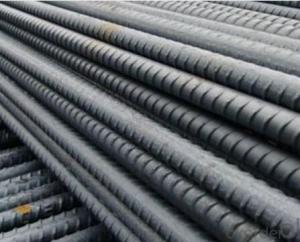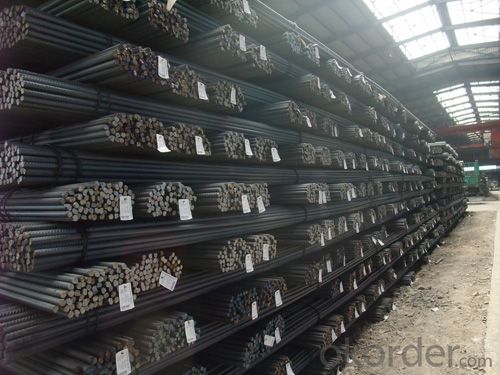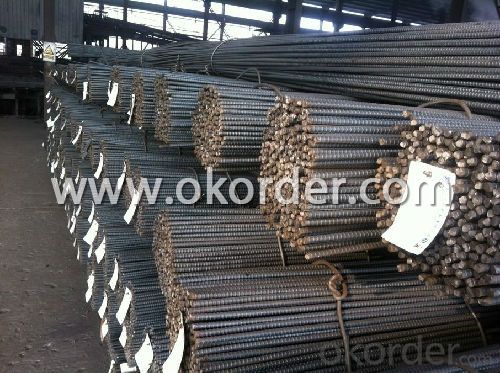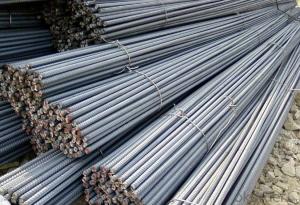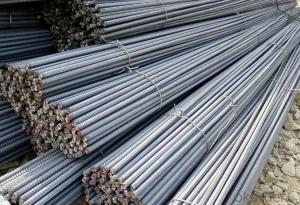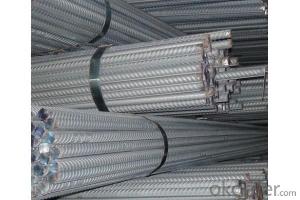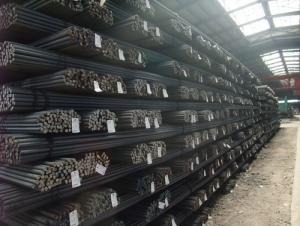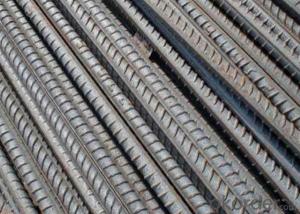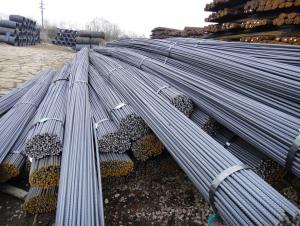HIGH QUALITY DIN HOT ROLLED STEEL REINFORCEMENT BAR
- Loading Port:
- Tianjin
- Payment Terms:
- TT OR LC
- Min Order Qty:
- 50 m.t.
- Supply Capability:
- 100000 m.t./month
OKorder Service Pledge
OKorder Financial Service
You Might Also Like
Product Description:
Specifications of Hot Rolled Steel Rebar:
The production process of Steel Rebar
1-Waling beam furnace 2-Roughing rolling group 3-Intermediate rolling train
4-Finishing rolling group 5-Water-cooling device 6-Walking beam cooler
7-Finishing equipment(including the cold scale shear,short feet collection system,
automatic counting device,bundling machine, collect bench)
Usage and Applications of Hot Rolled Steel Rebar:
Deformed bar is widely used in buildings, bridges, roads and other engineering construction. Big to highways, railways, bridges, culverts, tunnels, public facilities such as flood control, dam, small to housing construction, beam, column, wall and the foundation of the plate, deformed bar is an integral structure material. With the development of world economy and the vigorous development of infrastructure construction, real estate, the demand for deformed bar will be larger and larger..
Packaging & Delivery of Hot Rolled Steel Rebar:
Packaging Detail: products are packed in bundle and then shipped by container or bulk vessel, deformed bar is usually naked strapping delivery, when storing, please pay attention to moisture proof. The performance of rust will produce adverse effect.
Each bundle weight: 2-3MT, or as required
Payment terms: TT payment in advance or Irrevocable LC at sight.
Trade terms :FOB, CFR, CIF
Label:to be specified by customer, generally, each bundle has 1-2 labels
Note:
1. Our products are produced according to national standard (GB), if not, supply according to national standards (GB) or agreement as customer required.
2. Other Grade and Standard Deformed Steel Bar we can supply:
Grade: GR40/GR60, G460B/B500A/B500B/B500C,BST500S
Standard: ASTM, BS, DIN
The Minimum Order Quantity of these products is high, and need to be confirmed.
3. We can not only supply Deformed Steel Bar; if you need anything about building materials, please contact us for further information.
4. Please send us your detail specifications when inquire. We will reply to you as soon as possible. We sincerely hope we can establish a long stable business relationship.
- Q: What is the role of steel rebars in preventing cracks in concrete?
- Steel rebars play a crucial role in preventing cracks in concrete by providing tensile strength. As concrete is strong in compression but weak in tension, rebars act as reinforcement, absorbing and distributing the tensile forces that would otherwise cause cracks. By resisting the tension, rebars reinforce the concrete structure, enhance its durability, and ensure it remains stable and crack-resistant over time.
- Q: What is the effect of steel rebars on the formwork design?
- The formwork design in construction projects is significantly impacted by steel rebars. These reinforcement bars, also known as rebars, play a crucial role in providing strength and stability to concrete structures. One important aspect influenced by steel rebars in formwork design is the proper positioning and spacing of the rebars within the formwork. To ensure the structural integrity of the concrete element, the formwork must be designed to accommodate the rebars and allow for their correct placement. This may involve creating openings or recesses in the formwork to facilitate the passage of the rebars. The presence of steel rebars also affects the size and dimensions of the formwork. As the rebars occupy space within the concrete element, the formwork needs to be adjusted accordingly to accommodate these additional materials. This may require increasing the size or thickness of the formwork to provide the desired concrete cover over the rebars. Another factor influenced by steel rebars in formwork design is the consideration of the weight and load-bearing capacity of the formwork system. The addition of steel rebars significantly increases the weight of the concrete structure, necessitating the design of formwork that can withstand this additional load. This may involve using stronger and more durable materials for the formwork and ensuring proper bracing and support. Furthermore, the presence of steel rebars can impact the formwork construction process. The formwork design must carefully consider the installation and removal of the rebars without compromising the integrity of the formwork system. This may involve incorporating removable sections or panels in the formwork design to facilitate the placement and removal of the rebars. In conclusion, steel rebars have a profound impact on formwork design in construction projects. Proper consideration and planning are necessary to ensure the correct positioning, spacing, and support of rebars within the formwork. The presence of rebars also affects the size, dimensions, weight, and construction process of the formwork system. Overall, the successful construction of durable and structurally sound concrete elements relies on the proper integration of steel rebars within the formwork design.
- Q: Can steel rebars be used in the construction of nuclear power plants?
- Yes, steel rebars can be used in the construction of nuclear power plants. Steel rebars are commonly used as reinforcement in concrete structures, including those in nuclear power plants. They provide strength and stability to the concrete, ensuring the integrity of the structure. However, specific regulations and standards must be followed to ensure the rebars meet the required quality and safety standards for nuclear facilities.
- Q: Can steel rebars be used in tunnel construction?
- Yes, steel rebars can be used in tunnel construction. Steel rebars are commonly used in tunnel construction as they provide strength and reinforcement to the concrete structures. They help to enhance the structural stability and durability of the tunnels, making them capable of withstanding various forces such as ground movements, vehicular loads, and seismic activity.
- Q: How do steel rebars affect the overall thermal performance of a structure?
- Steel rebars can have a significant impact on the overall thermal performance of a structure. Due to their high thermal conductivity, steel rebars can act as thermal bridges, allowing heat to easily transfer from the warmer side to the cooler side of a structure. This can result in heat loss in cold climates and heat gain in hot climates, thereby reducing the overall energy efficiency of the building. To mitigate this effect, insulation materials can be used to separate the steel rebars from the building envelope and minimize thermal bridging.
- Q: How are steel rebars protected against rust or corrosion?
- Corrosion protection is essential for steel rebars to prevent rust and corrosion. Various methods are employed to ensure the durability and longevity of steel rebars in construction projects. Among these methods, the application of protective coatings, such as epoxy, zinc, or polyethylene, is commonly used. Epoxy coatings are frequently chosen because they create a formidable barrier against moisture and oxygen, effectively preventing rust formation. These coatings are typically fused onto the surface of the steel rebar through a process called fusion bonding, where the epoxy coating is melted and adheres to the steel. In contrast, zinc coatings are applied through galvanizing or metallizing. Galvanizing involves immersing the steel rebar in molten zinc, which forms a protective layer. Metallizing, on the other hand, entails spraying molten zinc onto the steel surface. Both methods produce a sacrificial zinc layer that shields the steel rebar from corrosion. Polyethylene coatings are also effective in corrosion protection. They are applied using a heat shrink process, where a polyethylene sleeve is wrapped tightly around the steel rebar and heated. This creates a robust and impervious layer that resists moisture and chemicals, guaranteeing long-term protection against rust and corrosion. Additionally, stainless steel rebars can be utilized to prevent corrosion. Stainless steel possesses innate corrosion-resistant properties due to the presence of chromium. The chromium forms a passive oxide layer on the surface, acting as a protective barrier against rust and corrosion. Therefore, stainless steel rebars are highly durable and long-lasting. In conclusion, safeguarding steel rebars against rust and corrosion is vital to ensure the structural integrity and longevity of construction projects. By applying protective coatings such as epoxy, zinc, or polyethylene, or by utilizing stainless steel rebars, the risk of corrosion is significantly minimized. This enables the steel rebars to endure harsh environmental conditions and remain intact for many years.
- Q: What is the ductility of steel rebars?
- The ductility of steel rebars refers to its ability to deform under tension without fracturing. Steel rebars are known for their high ductility, allowing them to withstand significant bending and stretching without breaking. This property makes them ideal for reinforcing concrete structures, where they can absorb and distribute loads effectively.
- Q: What are the different types of steel rebars used in road bridges?
- There are primarily two types of steel rebars used in road bridges: carbon steel rebars and epoxy-coated rebars. Carbon steel rebars are commonly used due to their high strength and durability. Epoxy-coated rebars, on the other hand, have an additional protective layer of epoxy coating to prevent corrosion and enhance longevity.
- Q: What are the different shapes and forms of steel rebars available?
- There are several different shapes and forms of steel rebars available, including plain round bars, deformed bars, epoxy-coated bars, and welded wire fabric.
- Q: Can steel rebars be used in combination with other reinforcement materials?
- Yes, steel rebars can be used in combination with other reinforcement materials such as fibers, wire mesh, or carbon fiber sheets to enhance the overall strength and durability of concrete structures. This combination of reinforcement materials provides a more effective solution for reinforcing concrete and can meet specific project requirements.
Send your message to us
HIGH QUALITY DIN HOT ROLLED STEEL REINFORCEMENT BAR
- Loading Port:
- Tianjin
- Payment Terms:
- TT OR LC
- Min Order Qty:
- 50 m.t.
- Supply Capability:
- 100000 m.t./month
OKorder Service Pledge
OKorder Financial Service
Similar products
Hot products
Hot Searches
Related keywords
